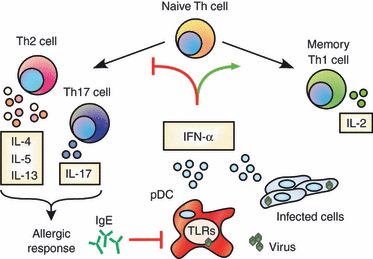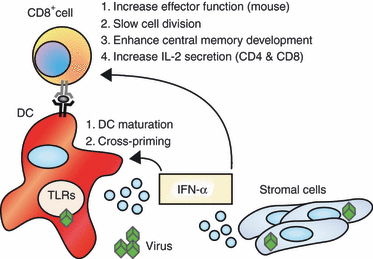Regulation of effector and memory T-cell functions by type I interferon
- PMID: 21320124
- PMCID: PMC3075500
- DOI: 10.1111/j.1365-2567.2011.03412.x
Regulation of effector and memory T-cell functions by type I interferon
Abstract
Type I interferon (IFN-α/β) is comprised of a family of highly related molecules that exert potent antiviral activity by interfering with virus replication and spread. IFN-α/β secretion is tightly regulated through pathogen sensing pathways that are operative in most somatic cells. However, specialized antigen-presenting plasmacytoid dendritic cells are uniquely equipped with the capacity to secrete extremely high levels of IFN-α/β, suggesting a key role for this cytokine in priming adaptive T-cell responses. Recent studies in both mice and humans have demonstrated a role for IFN-α/β in directly influencing the fate of both CD4(+) and CD8(+) T cells during the initial phases of antigen recognition. As such, IFN-α/β, among other innate cytokines, is considered an important 'third signal' that shapes the effector and memory T-cell pool. Moreover, IFN-α/β also serves as a counter-regulator of T helper type 2 and type 17 responses, which may be important in the treatment of atopy and autoimmunity, and in the development of novel vaccine adjuvants.
© 2011 The Authors. Immunology © 2011 Blackwell Publishing Ltd.
Figures


Similar articles
-
MyD88 and interferon-alpha/beta are differentially required for dendritic cell maturation but dispensable for development of protective memory against Listeria.Immunology. 2009 Nov;128(3):429-38. doi: 10.1111/j.1365-2567.2009.03128.x. Immunology. 2009. PMID: 20067542 Free PMC article.
-
Impairment of CD4+ T cell polarization by dengue virus-infected dendritic cells.J Infect Dis. 2011 Jun 15;203(12):1763-74. doi: 10.1093/infdis/jir197. J Infect Dis. 2011. PMID: 21606535
-
Interferon alpha/beta and interleukin 12 responses to viral infections: pathways regulating dendritic cell cytokine expression in vivo.J Exp Med. 2002 Feb 18;195(4):517-28. doi: 10.1084/jem.20011672. J Exp Med. 2002. PMID: 11854364 Free PMC article.
-
Type I interferon as a link between innate and adaptive immunity through dendritic cell stimulation.Leuk Lymphoma. 2004 Feb;45(2):257-64. doi: 10.1080/1042819031000149368. Leuk Lymphoma. 2004. PMID: 15101709 Review.
-
Multiple effects of immunostimulatory DNA on T cells and the role of type I interferons.Springer Semin Immunopathol. 2000;22(1-2):77-84. doi: 10.1007/s002810000028. Springer Semin Immunopathol. 2000. PMID: 10944802 Review.
Cited by
-
Deletion of A44L, A46R and C12L Vaccinia Virus Genes from the MVA Genome Improved the Vector Immunogenicity by Modifying the Innate Immune Response Generating Enhanced and Optimized Specific T-Cell Responses.Viruses. 2016 May 23;8(5):139. doi: 10.3390/v8050139. Viruses. 2016. PMID: 27223301 Free PMC article.
-
Serum Irisin Levels, Endothelial Dysfunction, and Inflammation in Pediatric Patients with Type 2 Diabetes Mellitus and Metabolic Syndrome.J Diabetes Res. 2020 Sep 4;2020:1949415. doi: 10.1155/2020/1949415. eCollection 2020. J Diabetes Res. 2020. PMID: 32964051 Free PMC article.
-
Linking tumor immune infiltrate and systemic immune mediators to treatment response and prognosis in advanced cervical cancer.Sci Rep. 2023 Dec 19;13(1):22634. doi: 10.1038/s41598-023-49441-2. Sci Rep. 2023. PMID: 38114557 Free PMC article.
-
IFNAR blockade synergizes with oncolytic VSV to prevent virus-mediated PD-L1 expression and promote antitumor T cell activity.Mol Ther Oncolytics. 2022 Mar 16;25:16-30. doi: 10.1016/j.omto.2022.03.006. eCollection 2022 Jun 16. Mol Ther Oncolytics. 2022. PMID: 35399605 Free PMC article.
-
Immune responses and immunotherapeutic interventions in malignant pleural mesothelioma.Cancer Immunol Immunother. 2011 Nov;60(11):1509-27. doi: 10.1007/s00262-011-1103-6. Epub 2011 Sep 13. Cancer Immunol Immunother. 2011. PMID: 21913025 Free PMC article. Review.
References
-
- Isaacs A, Lindenmann J, Valentine RC. Virus interference. II. Some properties of interferon. Proc R Soc Lond B Biol Sci. 1957;147:268–73. - PubMed
-
- Isaacs A, Lindenmann J. Virus interference. I. The interferon. Proc R Soc Lond B Biol Sci. 1957;147:258–67. - PubMed
-
- Stark GR, Kerr IM, Williams BR, Silverman RH, Schreiber RD. How cells respond to interferons. Annu Rev Biochem. 1998;67:227–64. - PubMed
-
- Hardy MP, Owczarek CM, Jermiin LS, Ejdeback M, Hertzog PJ. Characterization of the type I interferon locus and identification of novel genes. Genomics. 2004;84:331–45. - PubMed
-
- Pestka S, Krause CD, Walter MR. Interferons, interferon-like cytokines, and their receptors. Immunol Rev. 2004;202:8–32. - PubMed
Publication types
MeSH terms
Substances
Grants and funding
LinkOut - more resources
Full Text Sources
Other Literature Sources
Research Materials

